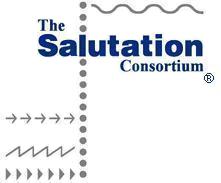
Salutation
Technical Committee Meeting #8
The 8th Salutation Consortium Technical Committee (TC) meeting was held at Sun
Microsystems, Menlo Park, California, USA, on October 13 and 14. 25 people attended from the
following 15 member companies:.
- Axis
- Canon
- Cisco
- Fuji Xerox
- HP
- IBM
- Lexmark
- Matsushita
- Mita
- Muratec
- Ricoh
- Sharp
- STS Consulting
- Sun
- Xerox
The meeting objectives were to discuss Salutation Architecture enhancement topics, and to
establish further work plans. Major agreements made were as follows:
- The TC understood that HP's JetSend and Salutation Architecture are complementary efforts,
and agreed to enable JetSend device discovery via Salutation. Following work items are
identified to accomplish this objective:
- add JetSend attribute to the existing FUs, and
- define a new FU for JetSend devices.
- The TC reviewed and agreed that print operations, printing parameters and job/equipment
status are easily mappable between Internet Printing Protocol and Salutation, so that
Salutation equipment can serve as IPP printers via a gateway server support for protocol
conversion. The TC will continue to watch the IPP activities.
- The TC reviewed the latest status of IETF Internet Fax activity. The TC will continue to
watch this activities.
- The TC agreed that the existing [DOC Storage] FU should not be utilized for e-mail/Fax
sending operation. Instead, a new FU should be defined in the future for e-mail/Fax.
- The TC agreed that the Salutation Manager (SLM) will use the Service Location Protocol
(SLP) to discover services beyond a single subnet, and that the Lightweight Directory Access
Protocol (LDAP)-enabled directory would be used via a gateway for services that require
global accessibility. The TC understood a need to work on standard directory schema for
device services. The schema definition should be easily mappable among the
Salutation-defined attributes, SLP schema, and LDAP schema definitions.
- The TC briefly discussed a new enhancement work item to define a Java API to enable server
applications to access office equipment so that ISVs will be encouraged to develop
applications which will work on any servers and which are independent of underlying protocol
between the server and equipment. The TC agreed to research related industry activities and
consider possible work scope for us, and to continue discussion at the next TC.

